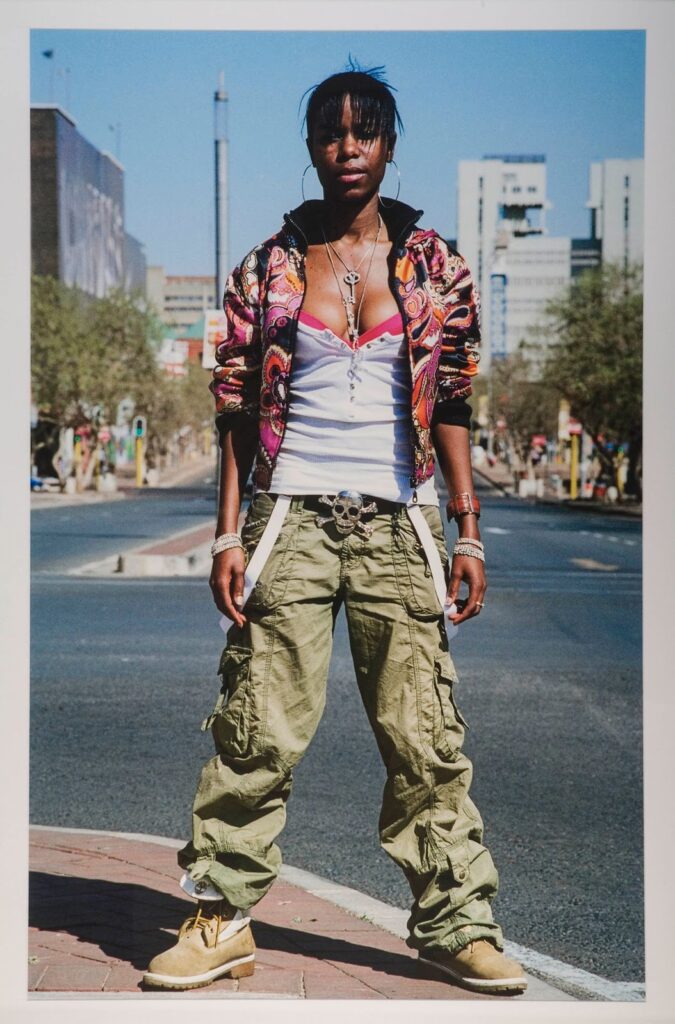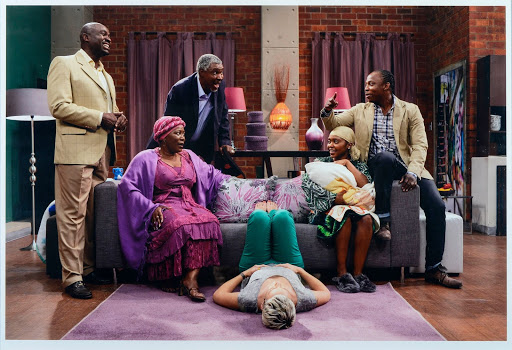Hasan and Husain Essop’s Facing Giblah, 2010, inhabits the mode of self-portraiture, accounting for several photographs in this Standard Bank Gallery exhibition.
Former president Nelson Mandela famously said, “If you talk to a man in a language he understands, that goes to his head. If you speak to him in his own language that goes to his heart.”
In a country with 11 official languages and countless more unofficial languages, people are often forced to live in a world in which they find themselves perpetually being lost in translation.
The current photographic exhibition at the Standard Bank Art Gallery in Johannesburg, Photographs In Our Mother Tongue, curated by Same Mdluli, showcases the works of more than two dozen prominent South African photographers from the titular bank’s corporate collection.
It’s an exhibition that asks if an image truly does speak a thousand words or if the same linguistic barriers that divide so many exist in an image as well. These questions are by no means simple to answer — the exhibition title perhaps provides a lens through which to address them.
 Nontsikelelo Veleko’s Lesego, Miriam Makeba Street, Newtown, Johannesburg, Gauteng, 2008
Nontsikelelo Veleko’s Lesego, Miriam Makeba Street, Newtown, Johannesburg, Gauteng, 2008
The focus is on images produced during South Africa’s political transition from 2003 to 2017, forcing us to interpret the early years of our democracy. The title raises the question of whether these images are shaped by and understood within the communities we belong to.
This was a time when the country’s citizens were wrestling with a new democratic identity. Works such as Candice Breitz’s Extra #5 and Jane Alexander’s Adventure Centre no. 5 evoke white vulnerability, displacement and alienation.
The photographs fall into two categories: those in which people are the focus, and photographs in which the environment is scrutinised. Within the group of artists who use people as their subjects there are further subcategories. Images from artists such as Mary Sibande, Hasan and Husain Essop, Breitz and Kathryn Smith, see the artist inhabiting the mode of self-portraiture; their images present a deeper incarnation of the self, separated from that of selfie culture — these are serious representations and depictions of South African life.
In the works of Nontsikelelo Veleko, Pieter Hugo and Kudzanai Chiurai, their subjects stare out at the viewer shrouded in personified airs of confidence or insecurity, or, at times, a combination of the two. In all these works, language and the sociopolitical capital it carries can be interpreted as reasons for the variations of perceived confidence.
 Jane Alexander, Adventure Centre 2000 No. 8 (2003)
Jane Alexander, Adventure Centre 2000 No. 8 (2003)
The power constructs of colonialism that we, as South Africans were subjected to, resulted in a sensitivity of being lesser-than for either speaking the language of the past oppressor (Afrikaans) or that of perceived intelligence (English).
The younger generation appears to be more secure in their identities. Veleko’s Lesego, Miriam Makeba Street, Newtown, Johannesburg, Gauteng 2008 is an illustration of this shift in self-perception. This image is the antithesis of all the aforementioned works, in that her subject is unapologetic for her existence; she takes full ownership of the space she inhabits as she stands rooted in the cityscape. She is not a part of many or in motion, but there to be boldly seen.
In contrast to these confrontational gazes are subjects viewed from behind, above or below, obscured by masks, blurred, silhouetted and distorted as in the works of Sabelo Mlangeni, Berni Searle, Alexander, Minette Vári and Pierre Croquet. In these instances the subjects and scenarios in which they are rooted are ambiguous. This ambiguity lessens the effects of language, because the power dynamics are nullified.
In the photographs in which the environments take the fore, the viewer is often seductively enticed into unpopulated landscapes pregnant with allusions to human existence. Images by David Goldblatt, Guy Tillim, Natasha Christopher, Bob Choops, Daniel Naudé, Obie Oberholzer and Georgia Papageorge are examples of this approach.
 Candice Breitz’s Extra! #5 (2011) exemplifies the sense of alienation white artists captured in the noughties.
Candice Breitz’s Extra! #5 (2011) exemplifies the sense of alienation white artists captured in the noughties.
Cityscape images, such as Andrew Tshabangu’s Passage, depict populated downtown street scenes, and Jo Ractliffe’s multi-perspective altar-like architectural depictions of the concrete jungle offer a stark contrast to the rural landscapes. Ractliffe’s spacially distorted triptychs provide dizzying representations of the urban landscape as seen in her Commissioner Street, Sauer Street, Johannesburg Central, whereas Santu Mofokeng’s Sacral Animals and Marcus Neustetter’s Shooting Star I, II & III present moody interplays of light and dark, bringing uneasy alien qualities to the familiar.
The works at this exhibition invite viewers to re-see rather than merely look — particularly given that most of these works are already well known to South Africans. The title of the exhibition provokes us to engage with each photograph and bring a part of ourselves to each of the visual conversations on display.
It was interesting to reflect on the time period of the images’ creation and what that era bestows onto our readings of the work. It’s clear that although these photographs may not entirely encompass the task this exhibition’s title sets out to achieve, this is the beginning of a much-needed conversation — a conversation that would require the inclusion of younger voices that illustrate the progression of this nation beyond that of the early freedom years. Such a conversation would truly find these photographs speaking to my heart rather than only my head. — African Art Features Agency, funded by the National Arts Council of South Africa
Photographs in our Mother Tongue is a virtual exhibition that can be viewed at https://sbvr.co.za/FpywXXa/gallery-01/?vr_entry_type=2d_now